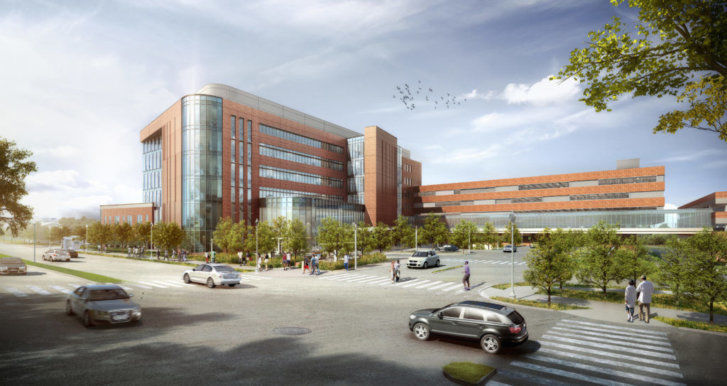
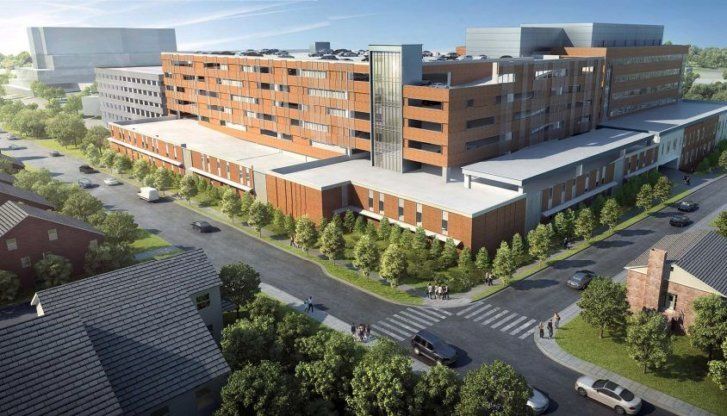
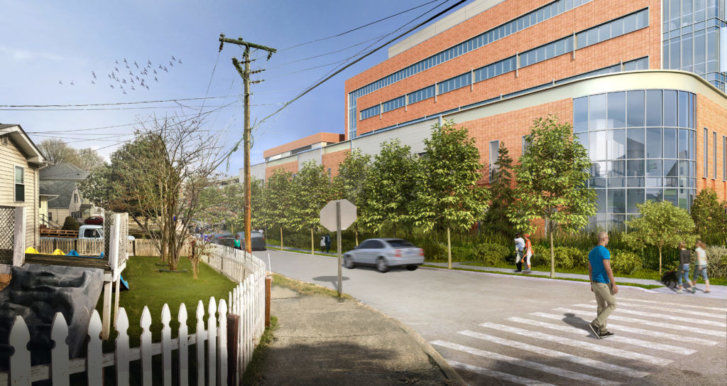
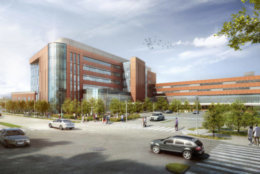
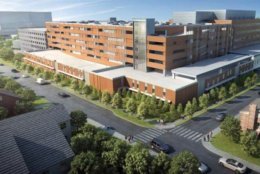
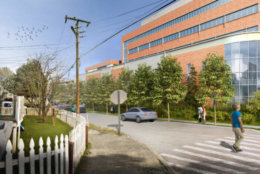
The Virginia Hospital Center will need to wait a bit longer to kick off its coveted expansion project, but Arlington officials are largely optimistic that they’ve charted out a path to help the county’s lone hospital meet some community concerns and ultimately win approval.
VHC, and the county’s business community, pressed hard to earn a green light from the County Board this weekend, in order to start work on a $250 million expansion the hospital says it desperately needs to manage demand. But the Board chose to follow the recommendation of its planners instead, and push back a final vote on the project until December.
Rather than ordering any substantial reworking of the project’s design, however, the Board asked that the hospital make some more modest changes to its plans.
While those alterations may not address each and every concern raised by people living nearby, who argue that the two new structures the hospital wants to build are hopelessly out of step with the surrounding community, county leaders hope they strike the right balance between addressing neighborhood worries and providing VHC with reasonable goals to meet.
“We didn’t want to kick this back to everybody to noodle over for the next three months,” Board Chair Katie Cristol told ARLnow. “We wanted to be clear about the targets the hospital needs to hit to reach approval… I do this think it’s likely that they meet these criteria. We tried to take the judgement calls out of it.”
Those new requests of VHC include a requirement to add better connections throughout the site of the expansion, in a lot on N. Edison Street immediately adjacent to its existing campus at 1701 N. George Mason Drive. As Cristol puts it, she wants to see less of a “superblock,” particularly after planners and neighbors balked at the potential of the proposed seven-story parking garage and 10-story outpatient facility to effectively wall off the hospital from single-family homes in the neighborhood.
The Board also wants to see the hospital spruce up the facade of the garage itself to help it better fit in to the community, and create a pedestrian connection between 19th Street N. and one of the expansion’s proposed terraces.
All of those requests seem reasonable enough to Adrian Stanton, VHC’s vice president of business development and community affairs. He told ARLnow that the hospital is, of course, “disappointed” by the Board’s decision to delay the proceedings, but largely optimistic about the project’s prospects.
“We’re very confident that we can work collaboratively with the county and community to iron out these remaining issues,” Stanton said. “I truly believe we will, and that’s where we appreciate the Board being very specific.”
But the Board’s requests won’t fundamentally impact a chief concern of many people living near the hospital: the size of the new buildings.
The county’s Planning Commission urged the Board to force VHC to move the largest structures closer to the center of the site, in order reduce their impact on the community. Neighbors similarly hoped for larger setbacks or other measures to help the structures better blend into the area, but felt those requests went ignored.
“None of these hopes were realized,” Suzanne Nirschl-Brown, head of the nearby Taratown Homeowners Association, told the Board Saturday. “We’re the ones with the towering structures close to our homes.”
However, Stanton noted that the hospital is fundamentally “landlocked” by those single-family homes and will need to build large structures to make any expansion happen. Cristol added that VHC did also reduce the size of its garage, simultaneously shrinking the structure and satisfying the demands of transit advocates concerned that offering so many parking spaces would encourage employees to drive to the hospital.
Planners are also concerned that the hospital still hasn’t done enough to lay out what its future construction on the site might look like. Once it can complete the expansion, the hospital hopes to overhaul its existing campus over the coming decades — the Planning Commission called for VHC to go through a different process known as a “phased development site plan” to help the county better scrutinize those long-range plans.
Yet Stanton says that the constantly changing nature of the healthcare industry would’ve made it difficult to predict exactly what sort of facilities the hospital will need to build so far in the future. He added that VHC also fully plans to go through the PDSP process when it proposes any design for a future overhaul of its campus, which he doesn’t expect to happen for the next 10 to 15 years.
The Board agreed to that condition, even if it doesn’t quite meet the demands of planners.
“That’s akin to closing the barn door after the horse is gone,” Planning Commissioner Nancy Iacomini said Saturday. “One of the most important things a PDSP does is make the edge of a site match its context.”
Still, Stanton pledged to work closely with the community over both the next three months and the coming years on all manner of designs. Cristol and her fellow Board members agreed that was well warranted, given the hours of public comment they heard Saturday.
Cristol pointed out that tensions between VHC and its neighbors “go back decades.” One resident of the nearby Halls Hill neighborhood, Tia Alfred, compared the hospital’s design to the infamous “wall” used to separate the historically black community from its white neighbors decades ago.
To some Board members, such recriminations suggested that a lot more community engagement is needed on VHC’s part.
“If only VHC would treat their neighbors the way they treat their patients,” Board member Libby Garvey said Saturday. “I really hope this is one of the first steps between a repaired relationship between the hospital and the neighborhood.”
Stanton says VHC staff will meet with community members “as frequently as they request,” but did underscore the urgency of the hospital’s expansion, nonetheless. He noted that VHC regularly has to send patients seeking some mental and behavioral health services elsewhere, and will continue to feel a squeeze in its emergency rooms until the expansion can move forward.
Stanton added that the hospital expects construction to take from 24 to 30 months, and it will only be able to offer more in-patient beds on its current campus once it can build the new outpatient facility. The county has its own interest in seeing the project go forward as well, as it’s set to provide the Edison Street property with the hospital in a swap for a property on S. Carlin Springs Road.
But even with those pressing needs, and the Board’s specific guidelines, county officials warn that they’re not willing to simply offer a rubber stamp to the plan three months from now.
“I’m not going to support any proposed solutions for today’s problem if I believe it’s going to cause more problems the next time around,” Board member Erik Gutshall said Saturday. “Come back to us with what’s really your best and final offer.”







